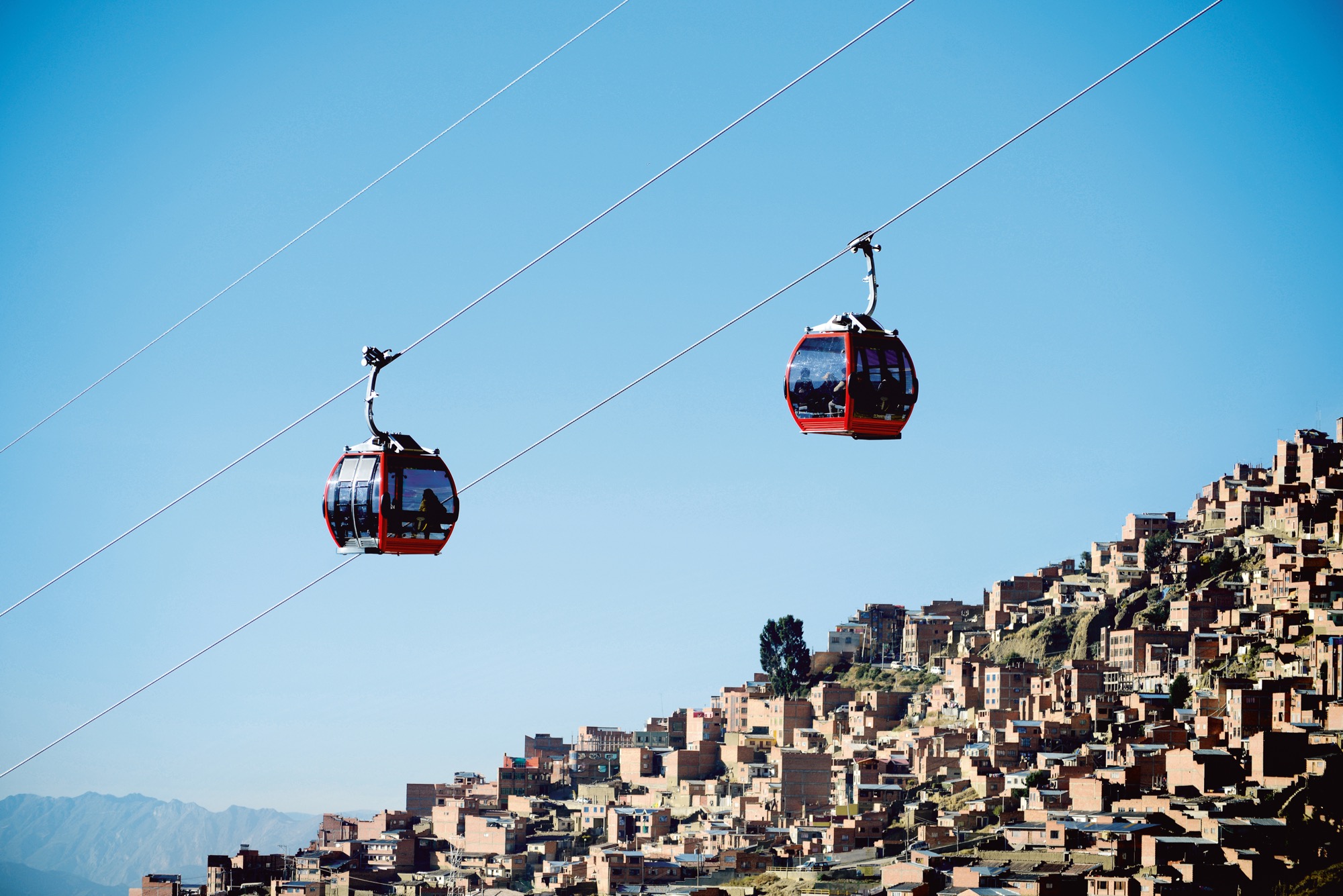
Cities, SI Urban 1/2021
Comparative study confirms advantages of the “Third dimension”
How was the comparison made?
To facilitate scientific comparison of the different modes of transport, a functional entity was formed in accordance with ISO 14040/14044. Comparability was achieved by comparing the complete lifecycles of the different systems, from production through operation to disposal.
It is important here that the systems to be compared should fulfil the same transport requirement, from A to B. The lifecycle analysis with an open approach to recycling therefore produces real footprints of total emissions.
The cable car starts from 16 de Julio station in El Alto, terminates at Estación Central in La Paz and overcomes an altitude difference of 402 metres. The comparison is based on an average operating day with 69-percent capacity use, i.e. 2,059 people per hour and direction.
This 17-hour operating day is applied for 365 days per year, over a service life of 30 years, in order to determine the operating phase. The cable car investigated is 2,349 metres long.
The alternative, a bus service, is possible only over a 12.4-kilometre route and the same route has been assumed for capacity use of the fictitious tram.
By contrast, the cable car mobility solution implemented by the city uses the third level and floats over the urban traffic, shortening the route by 10.1 kilometres. This also has a positive effect on the journey time; the trip takes only ten minutes, with no waiting time for users, owing to the continuous availability of the gondolas.
By bus or tram, on the other hand, the journey would take at least 18 minutes – as long as there were no congestion.
What are the results?
In terms of overall ecological impact, the differences between the transport systems are striking: whereas a small bus generates the equivalent of 267,197 tonnes CO2, the cable car is responsible for the equivalent of only 48,205 tonnes CO2. The differences from the large bus (242,197 tonnes) and tram (215,093 tonnes) are also substantial.
These figures relate to the complete product lifecycle – from cradle to grave. For the “Línea Roja” cable car, it can be seen that use accounts for the majority (82.5 percent) of the greenhouse gases.
The materials make up only 11 percent of the ecological footprint. By contrast, the other phases – production (0.5 percent), distribution (3 percent) and end of life (3 percent) – produce few greenhouse gases. End of life refers to dismantling and disposal of the installation after 30 years, without factoring in any credit for recyclable materials.
With the equivalent of 39,804 tonnes CO2, the cable car operating phase (the use) is therefore the largest emitter within the product phases. The distribution between power mix and maintenance during cable car operation must be considered here: the Bolivian power mix accounts for 92 percent of greenhouse gas emissions; maintenance accounts for eight percent.
What can we conclude from this?
Once again, the results confirm the urban cable car as the most sustainable mode of transport. With cable car technology that has been tried and tested over decades in urban mobility, cable car manufacturers such as DOPPELMAYR are helping cities to maintain the quality of life of present and future residents, in line with UN sustainable development goal 11: sustainable cities and human settlements.
The cable car is a reliable, easily integrated and networkable solution in urban mobility. Three points are especially significant here:
First: A cable car can help cities to accelerate decarbonisation: the cable car causes no local emissions, e.g. from nitrogen oxides (NOx) or particulates. Overall, it has the smallest carbon footprint in comparison with other transport systems. And, not least, the electric drive achieves maximum energy performance and a high level of efficiency.
Second: The cable car represents an environmentally friendly mobility solution, which improves the quality of life in cities. It therefore also improves air quality and reduces noise, if it replaces other modes of transport. The small space requirement allows implementation in the urban environment and ensures that buildings, green areas and monuments can be preserved.
Third: The cable car creates accessible mobility for all. Boarding and alighting are barrier-free. It is therefore easy to use for people with limited mobility. In circulating operation, the constant availability of the gondolas means that there are no waiting times and capacity of up to 6,000 people per hour and direction can be achieved here. Last but not least, the cost efficiency in implementation and operation allows socially acceptable pricing for all users.
Source: Jörg Niemann, Julian Bruckmann and Florian Krautzerg (2020): Green City Deals: A study on the global warming potential of alternative urban transportation systems. Online at https://doi.org/10.20385/kd43-fz18.







